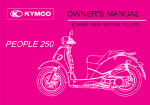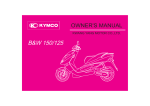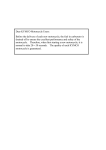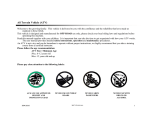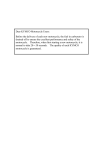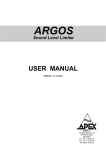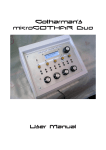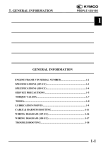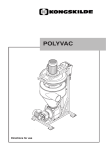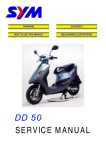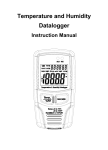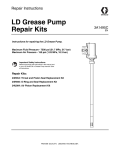Download Owners Manual
Transcript
DRIVER'S MANUAL KWANG YANG MOTOR CO.,LTD. SUPER8 50/125 KWANG YANG MOTOR CO.,LTD. NO.35 Wan Hsing Street, San Min District Kaohsiung, Taiwan, Republic of PROC Telephone : 886-7-3822526 FAX : 886-7-3950021 Dear KYMCO Scooter Users: Thank you for purchasing this KYMCO scooter and welcome to the family of KYMCO scooter riders. To enjoy safer and more pleasant riding, become thoroughly familiar with this owner's manual before you ride the scooter. You safety depends not only on your own alertness and familiarity with the scooter but also the scooter mechanical condition. A pre-ride inspection before every outing and regular maintenance are essential. The quality of each KYMCO scooter is guaranteed. Note: 1. The information and specifications stated in this manual are for reference only and subject to change without notice. 2. When starting the engine, the battery must be installed to facilitate starting and increase the engine performance. TABLE OF CONTENTS 1.PRECAUTIONS FOR A SAFE RIDING 2.PARTS LOCATION FRAME NUMBER ENGINE NUMBERKEY NUMBER 3.OPERATION INSTRUCTIONS IGNITION SWITCH/STEERING HANDLEBAR LOCK ELECTRIC STARTER BUTTONHEADLIGHT SWITCH HEADLIGHT DIMMER SWITCH/PASSING SIGNAL SWITCH HORN BUTTON/TURN SIGNAL SWITCH SEAT LOCK/MET-IN BOX HELMET HOLDER INSTRUMENTS AND INDACATORS 4.PRE-RIDE INSPECTION ADVANCE INSPECTIONENGINE OIL LEVEL INSPECTION/REFILLING BACK STEP USE TIRE INSPECTION 1 3 7 8 9 9 10 11 12 13 13 14 16 16 18 19 TABLE OF CONTENTS FUEL LEVEL INSPECTION/REFILLING STEERING HANDLEBARINSTRUMENT LIGHTS INSPECTION BRAKE FLUID LEVEL INSPECTION BRAKE PAD WEARBRAKE SHOE WEAR BRAKE LEVER FREE PLAY INSPECTION & ADJUSTMENT HORN/LIGHT INSPECTION 21 22 23 24 25 27 FRONT/REAR SHOCK ABSORBER INSPECTIONBRAKE PERFORMANCE INSPECTIONBACK MIRROR ANGLE CHECKLICENSE PLATE CHECK REFLECTOR CHECKPREVIOUS ABNORMAL PARTS INSPECTION LUBRICATION POINT CHECK 5.ENGINE STARTING METHODS 6.NORMAL RIDING METHOD 7.PRECAUTIONS FOR RIDING 8.HOW TO STOP RIDING 9.EASY MAINTENANCE AIR CLEANER CLEANING & REPLACEMENT APPEARANCE CLEANING 28 29 33 35 39 41 41 43 TABLE OF CONTENTS BATTERY FUSE CHANGE TRANSMISSION GEAR OIL 44 46 48 SPARK PLUG INSPECTION BRAKE FLUID LEVEL INSPECTION/REFILLINGRUBBER COVER 49 INSPECTION FOR WIRE AND CABLE 50 51 52 53 54 10.IMPORTANT NOTICES POLLUTION-FREE PERIODIC MAINTENANCE SCHEDULE SPECIFICATIONS 11.KYMCO CLEAN AIR SYSTEM (FOR EURO 2) 1.PRECAUTIONS FOR A SAFE RIDING (1) CLOTHES To relax and wear comfortable clothes are the main points for a safe riding. To observe traffic laws, keep a cool mind, relax and be careful will provide you a safe riding. (1) Wear helmet and fasten it tightly. (2) Have the clothes well-arranged. Fasten shirt cuffs and keep them from hooking the brake lever. (3) Wear low-heeled shoes for a safe riding. (4) When riding, use both hands to grasp the handlebar. it is very dangerous to hold the handlebar with one hand. (4) (2) (1) CAUTION: A scooter rider should not wear loose or too long clothes to avoid danger. During riding or 10 minutes after the scooter is stopped, do not touch the exhaust muffler to avoid scalding. When parking the scooter, keep it away from dry lawn or inflammables to avoid danger. ⌒1⌒ (3) (2) RIDING METHOD The safety of two-wheel vehicles is influenced by sitting position. The rider should sit on the central part of the seat cushion. If the rider sits on the rear part of the seat, the load of front wheel will decrease. As a result, the handlebar will swing and cause danger to the rider. When making a turn, it will be easier for the rider to steer the scooter by leaning the body inward slightly. The scooter will lose its balance if the rider fails to keep his body leaning inward. When riding on a damaged or macadam road. Slow down the speed and hold the handlebar tightly. (3) CARRYING GOODS Keep a good sitting posture to operate the scooter properly. The feel of the handlebar will be different when carrying goods on the scooter. Overloading may cause the handlebar to swing. Avoid riding with overload. (1) Max. loading capacity of the met-in box is 10kg. (2) Max. loading capacity of the rear carrier is 5kg. ⌒2⌒ (1) (2) 2. PARTS LOCATION (5) (1) Headlight switch (P.10)/ Electric starter button (P.10) (2) Tun right signal indicator light (P.15) (3) Speedometer (P.14) (4) Tun left signal indicator light (P.15) (5) Headlight dimmer switch (P.11)/ Passing signal switch (P.11)/Turn signal switch (P.12)/Horn button(P.12) ⌒3⌒ (4) (3) (2) (1) (5) (1) Seat lock (P.13) (4) (3) (1) (2) (2) Fuel fill cap (P.21) (3) Met-in box (P.13) (4) Helmet holder (P.13) (5) Center hook (6) Side stand (7) Main stand (8) Kickstarter pedal (P.32) (9) Air cleaner housing (P.41) (6) (7) (8) (9) ⌒4⌒ (3) (1) Ignition switch (P.9) (2) Helmet holder (P.13) (3) Engine oil tank cap (P.16) ⌒5⌒ (2) (1) (3) (1) Low oil level indicator (P.15) (2) (1) (2) Rear brake lever (P.25) (3) Battery (P.44)/Fuse (P.46) (4) Throttle grip (5) Front brake lever (6) High beam indicator light (P.25) (4)(5) (6) ⌒6⌒ FRAME NUMBER The read frame number, please remove the cover on inner cover with a flat head screwdriver. Always check that the frame number stamped on your scooter is the same written in document and warranty scooter is the same written in document and warranty card. Please write down your frame number in place below. FRAME NUMBER: ENGINE NUMBER The engine number is stamped on right engine case. Please write down your engine number in place below. ENGINE NUMBER: KEY NUMBER The key number (1) will be needed when you order replacement part. Record the number for your reference. KEY NUMBER: (1) ⌒8⌒ 3. OPERATION INSTRUCTIONS (1) IGNITION SWITCH/STEERING HANDLEBAR LOCK (1) ON : At this position, power is connected to start the engine. The key cannot be taken out. (2) OFF : At this position, power is cut off and the engine stops. The key can be taken out. (3) LOCK : At this position, the steering handlebar is locked. The key can be taken out Locking Method Turn the steering handlebar left to the full and then push and turn the ignition switch key left to the "LOCK" position the handlebar can be locked. Unlocking Method Turn the ignition switch key right to the"OFF" and the "LOCK" is released automatically. CAUTION: After locking, turn the handlebar gently to make sure that it is locked. Do not turn the ignition switch to the"LOCK" position during riding, otherwise the handlebar will be out of control and cause accidents. Don't park your scooter at a place to hinder the traffic. ⌒9⌒ (2) (3) (1) (2) ELECTRIC STARTER BUTTON " " To start the engine, first turn on the ignition switch "ON "and then push the electric starter button. At this time, be sure to fully apply the front or rear brake lever in order to connect the power. CAUTION: During engine running, do not push the electric starter button to avoid engine damage. Turn the headlight switch off and turn signal switch off before using the electric starter button. Release the electric starter button immediately after the engine is started. (3) HEADLIGHT SWITCH At this position, the position light, headlight, instrument lights and taillight turn off together. At this position, the position light, instrument lights and taillight light turn on. At this position, the position light, headlight, instrument lights and taillight light all turn on. ⌒1 0⌒ (4) HEADLIGHT DIMMER SWITCH/PASSING SIGNAL SWITCH (1) (2) Switch to this position for using high beam. When riding in downtown area or there is a car coming from the opposite direction, use low beam to avoid affecting the visibility of coming cars. (1) (2) PASSING CAUTION: This indicator light comes on when the long distance light is turned on. PASSING When passing, if there are cars coming from the opposite direction, press and release the PASSING switch and the headlight will wink to warn the coming cars. ⌒1 1⌒ PASSING (5) HORN BUTTON " "/TURN SIGNAL SWITCH When the ignition switch key is turned the"ON" position, push the horn button and it will sound. Move the turn signal switch to (1) For turning to the right. (2) For turning to the left. (3) Push the turn signal switch button to release it. (4) Horn Button. The horn and turn signal switch do not work when the ignition switch is the"OFF". CAUTION: The turn signal light will not release automatically. Be sure to reset it after use; otherwise it may affect the traffic safety. ⌒1 2⌒ PASSING (2) (1) (3) (4) (6) SEAT LOCK/MET-IN BOX Unlock the seat and put the helmet in the MET-IN box. Unlocking Method Stop the engin and turn the ignition switch to the "OFF" position. Insert the ignition switch key into the seat lock and turn it clockwise.. To lock the seat, push on it until it lock automatically. Make sure the seat is secure before riding. CAUTION: Never put the key inside the seat cushion to lock the seat. (7) HELMET HOLDER 1.Open the seat with the ignition switch key and lift up the seat. 2.Put the helmet retaining ring into the helmet holder. 3.Put down the seat and it will lock automatically. Take out the helmet in the reserve order of the above steps. CAUTION: When riding, wear the helmet and do not retain it on the scooter; the helmet may interfere with safe operation and result in loss of control. ⌒1 3⌒ (8) INSTRUMENTS AND INDACATORS (4) (1) FUEL GAUGE: The fuel gauge is to show the volume of gasoline in the fuel tank. If the fuel gauge pointer is at the "E" area, the fuel is insufficient. Refill 92# or 95# nonleaded gasoline as early as possible. (2) SPEEDOMETER (km/hour): The riding speed is indicated by km/hour. (3) SPEEDOMETER (mph): The riding speed is indicated by mph. (4) ODOMETER: The total riding mileage is indicated by kilometer. The figure in black and white is an unit of 100m. (5) CLOCK METER: It displays time and date which can be adjusted manually. (6) ADJUST KEY: They are used to correct time and date. ⌒1 4⌒ (5) (3) (2) (6) (1) (7) TURN SIGNAL INDICATOR LIGHT(LEFT): When the turn signal switch is operated, this indicator light will wink. (8) LOW OIL LEVER INDICATOR: When the ignition switch is "ON", it is normal if the low oil lever indicator light comes on for several seconds and then goes out. If the light does not go out, it means that the 2-stroke engine oil is insufficient. Please refill with the specified engine oil. (9) HIGH BEAM INDICATOR LIGHT: This indicator light comes on when the long distance light is turned on. (10) TURN SIGNAL INDICATOR LIGHT(RIGHT): When the turn signal switch is operated, this indicator light will wink. ⌒1 5⌒ (9) (7) (8) (10) 4. PRE-RIDE INSPECTION (1) ADVANCE INSPECTION Get into a good habit of inspection before riding. For the sake of safety and to prevent vehicle damage and traffic accidents, the pre-ride inspection is absolutely required. CAUTION: Be sure to perform inspection and maintenance for your new scooter after it is ridden for 300km. (2) : ENGINE OIL LEVEL INSPECTION/REFILLING When the low oil level indicator lights, it means the oil level in the oil tank is low; stop the engine and fill the oil tank as soon as possible. To fill, lift the seat (page 13), remove the cap (1) from the oil tank. ⌒1 6⌒ (1) Fill with the recommended oil up to the upper level mark (2). Oil recommendation: Use KYMCO 2-stroke oil or its equivalent. CAUTION: If the low oil level indicator comes on while riding, stop riding and shut the engine off. Fill the oil tank to the upper level mark with the recommended oil . Continuing to ride with a low oil level may lead to engine failure that could result in an accident. If the engine has been run after the low oil level indicator has come on, the scooter must be taken to an authorized KYMCO dealer for inspection and bleeding of the oil system. Failure to do this will result in serious engine damage. The use of improper oils may cause excessive and/or premature carbon build-up in the engine and exhaust system, resulting in loss of power and possible engine damage. When filling, do not let dirt or other foreign materials enter the tank. ⌒1 7⌒ (2) (3) BACK STEP USE 1. When using it, pull the back steps lever butteon,to back steps lever flick. 2.When not using it, push the back steps lever,comeback it to original position. ⌒1 8⌒ (4) TIRE INSPECTION 1.Tire Pressure Check Check if the tire pressure is normal when the tire is in contact with level ground. If there is any abnormal condition, check the tire pressure with a tire pressure gauge. Measure the tire pressure under room temperature. 2 The tire pressure must not overpass 2.50kg/cm NORMAL PRESSURE(1 Rider / 2 Riders ) Front Wheel 1.5/2.0 kgf/cm2 Rear Wheel 1.75/2.25 kgf/cm 2 ⌒1 9⌒ 2. Cracks & damage Check the tire-contact area for crack or damage. 3. Abnormal wear Check the tire-contact area for abnormal wear. 4. Foreign objects of metal piece & gravel Check the tires and tire-contact area for imbedded objects of metal piece and gravel. 5. Depth of tire groove If the tire is worn to the wear limit indication mark, Replace it with a new one. 4. 5. 5. CAUTION: Abnormal tire pressure, crack, damage and abnormal wear will cause unsteady handlebar and result in tire break. If the tire has cracks or is worn to the wear limit indication mark, replace it with a new one. ⌒2 0⌒ 2. 3. 2. (5) FUEL LEVEL INSPECTION/REFILLING Check if the fuel is sufficient. If the fuel gauge pointer is at "E" grid, refill #92 or #95 nonleaded gasoline as soon as possible. (2) (1) Refilling Method 1.Lift the seat (page 13), then remove the fuel fill cap (1) by turning it counterclockwise. 2.After refueling, be sure to tighten the fuel fill cap firmly by turning it clockwise. Make sure that the allow marks (2) on the fuel fill cap and fuel tank is aligned. CAUTION: Use unleaded fuel only because it produces fewer engine and spark plug deposits and extends the life of the exhaust system. Do not overfill the tank (there should be not fuel in the filler neck (3) after refueling, make sure the fuel fill cap is closed securely. ⌒2 1⌒ (3) (6) STEERING HANDLEBAR Visually inspect the steering handlebar for damage. Apply the front brake and move the handlebar upward and downward to check for abnormal noise. Move the steering handlebar upward, downward, rightward and leftward to check for any loose parts. Check if the handlebar rotates freely. If any abnormal condition is found, go to your scooter dealer or for inspection. (7) INSTRUMENT LIGHTS INSPECTION Check the turn signal indicator lights and high beam indicator light for proper operation. Check the speedometer for proper operation. Check the fuel gauge for proper operation. Check the low oil lever indicator light for proper operation. ⌒2 2⌒ (8) BRAKE FLUID LEVEL INSPECTION Check if the fluid level is below the lower level mark through the inspection window. CAUTION: As the brake pads wear, brake fluid level drops, automatically compensating for wear. There are no adjustments to perform, but fluid level and pad wear must be inspected periodically. The system must be inspected frequently to ensure there are no fluid leaks. If the brake lever travel become excessive and the brake pads are not worn beyond the recommended limit, There is probably air in the brake system and it must be bled. See your authorized KYMCO dealer for this service. To prevent damage to the brake system, use only fluid from a sealed container. Never allow contaminants (dirt, water, etc.) to enter the brake fluid reservoir. Brake fluid can damage paint and plastic, so handle the fluid with care. When adding brake fluid, be sure the reservoir is horizontal before removing the cover to prevent accidental spilling. Use only DOT 4 brake fluid from a sealed container. ⌒2 3⌒ (9) BRAKE PAD WEAR Check the wear indicator mark on each pad. If either pad is worn to the wear indicator mark, replace both pads as a set. See your authorized KYMCO dealer for this service. (10) BRAKE SHOE WEAR The rear brake is equipped with a brake wear indicator. When the brake is applied, an arrow mark (1) attached to the brake arm moves toward a reference mark (2) on the brake panel. If the arrow mark aligns with the reference mark on full application of the brake, the brake shoes must be replaced. See your authorized KYMCO dealer for this service. (2) ⌒2 4⌒ (1) (11) BRAKE LEVER FREE PLAY INSPECTION & ADJUSTMENT The rear brake lever free play should be adjusted to 10~20mm (0.4~0.8 in) at the tip of the brake lever. If the free play is incorrect, adjust as follows: Place the scooter on its main stand. Turn the adjusting nut in direction (A) to decrease play, and in direction (B) to increase play. 1~2cm Turn the adjusting nut on the brake hub in direction (A) to decrease play, and in direction (B) to increase play. (A) (B) (1) ⌒2 5⌒ CAUTION: Make sure the cut-out on the adjusting nut (2) is seated on the brake arm pin (1) after making final free play adjustment. (1) ⌒2 6⌒ (2) (12) HORN/LIGHTS INSPECTION Turn the ignition switch to the "ON" position and push the horn button to check if it sounds. Headlight/Taillight Inspection: Start the engine and turn on the headlight switch to check if the headlight and taillight are good and check the light shells for dirt and damage. Stoplight Inspection: Apply the front and rear brake levers respectively to check if the stoplight is good. And also check the stop light shell for dirt and damage. Turn Signal Light Inspection: Operate the turn signal switch to make sure whether the right/left front and rear turn signal lights can wink and buzz. Also check the light shells for dirt and damage. (1)Headlight (2)Taillight/ Stoplight (3)Turn signal light (4)Horn button CAUTION: Replace any dirty or damaged lights with new ones to avoid danger during riding. ⌒2 7⌒ (3) (1) (2) PASSING (13) FRONT/REAR SHOCK ABSORBER INSPECTION Check the condition of the front/rear shock absorbers by pressing down on the handlebar and seat several times. (14) BRAKE PERFORMANCE INSPECTION Fully apply the front and rear brake levers and move the scooter forward to see if the braking effect is good. (15) BACK MIRROR ANGLE CHECK Sit on the scooter uprightly and make a viewing test of the rear mirror angle. (16) LICENSE PLATE CHECK Check the license plate for dirt and damage, then tighten it. (17) REFLECTOR CHECK Check the reflector for dirt and damage. (18) PREVIOUS ABNORMAL PARTS INSPECTION Make sure that the previous abnormal parts are repaired. (19) LUBRICATION POINT CHECK Visually check if all motorcycle lubrication points are lubricated properly. ⌒2 8⌒ Oil 5. ENGINE STARTING METHODS (1) TURN THE IGNITION SWITCH "ON" Unlock the steering handlebar. Turn the ignition switch to the "ON" position. CAUTION: Check the gasoline volume and engine oil level before starting the engine. Be sure to erect the main stand while starting the engine and side stand is up. Before starting the engine, the side stand shall be kicked up to secure safety. (2) LOCK THE REAR WHEEL Apply the brake lever to connect the power for starting. CAUTION: In order to prevent the scooter from rushing out at high speed, make sure to lock the rear wheel. If free play of the rear brake lever is incorrect, the rear wheel cannot be braked and it will cause danger easily. ⌒2 9⌒ (3) USE THE ELECTRIC STARTER BUTTON Push the electric starter button without rotating the throttle grip. If the engine fails to start after the electric starter button is pressed for 3~4 seconds when it is warm, rotate the throttle grip for 1/8~1/4 turn to facilitate starting. When the scooter is not used for a long time or the fuel tank is empty, if the engine is still hard to start after the fuel tank is refilled with gasoline, slightly turn the throttle grip and push the electric starter button for several times to start the engine. In order to avoid battery overcharge, do not push the starter button more than 5 seconds. If the engine does not start after the electric starter button is pushed for 5 seconds, wait for more than 5 seconds and then push the button again. ⌒3 0⌒ 1/8~1/4 CAUTION: Don't push the electric starter button while the engine is running; otherwise the engine will be damaged. When starting the engine, the rear brake lever must be applied to connect power and the stoplight will come on when power is connected. ⌒3 1⌒ (4) START WITH THE KICK PEDAL 1.Place the scooter on its main stand on level ground. 2.Depress the kick pedal with force. When the engine is cold and does not start after the kick pedal is depressed for 3~4 times, rotate the throttle grip for 1/8~1/4 turn to facilitate starting. Warm up the engine for a little while (about 2°3 minutes) after cold start. After the engine is started, do not accelerate suddenly and keep riding at low speed to prolong the engine service life. CAUTION: After the engine is started, the kick pedal must be returned to its original position. The exhaust contains poisonous carbon monoxide which is harmful to human body. Never run the engine in a closed area. Turn off all light switches before starting the scooter. ⌒3 2⌒ 1/8~1/4 6. NORMAL RIDING METHOD (1) STARTING THE ENGINE Start the engine by referring to the starting methods specified in Section 5. CAUTION: Keep your finger away from the button immediately after the engine is started to avoid engine damage. The rear brake lever should be kept at the braking position before riding. (2) REBOUND THE MAIN STAND Keep the rear brake lever at braking position and push the scooter forward, then the main stand will rebound automatically. CAUTION: After starting the engine and before moving, do not turn the throttle grip to increase the engine rpm. ⌒3 3⌒ (3) CORRECT SITTING POSITION Ride astride on the scooter from the left side and sit upright. Touch the ground with left foot to avoid slipping. CAUTION: The rider must wear helmet, gloves and goggles. Do not wear any clothes which will affect riding safety. (4) ROTATE THE THROTTLE GRIP Release the rear brake lever and slowly rotate the throttle grip, then the scooter will move smoothly. CAUTION: After the rear wheel brake lever is released, do not rotate the throttle grip suddenly to prevent the scooter from rushing out. During riding, do not accelerate or decelerate rapidly and suddenly to save fuel and prolong the scooter life. ⌒3 4⌒ 7. PRECAUTIONS FOR RIDING (1) CORRECT RIDING Before moving, turn on the turn signal light and make sure whether the rear side is safe. Do not rush into the car lanes and always keep the scooter to the right side to avoid danger. CAUTION: Moderate riding will prolong the engine service life. The clutch linings are worn more quickly when often ridden at low speed. (2) SPEED CONTROL The speed is controlled by the throttle grip. (1) ROTATE: The speed will become faster. Don't be hasty to accelerate. When riding on an ascending road, rotate the throttle grip gradually to increase the horse power. (2) RESTORE: The speed will become slower. Restore the throttle grip quickly. (2) CAUTION: Apply the brake level while restoring the throttle grip. This will shorten the time required to slow down. ⌒3 5⌒ (1) (3) PROPER RIDING WILL PROLONG THE ENGINE LIFE For a new scooter, keep the speed below 30km per hour within the first 1000km of riding. Avoid sudden acceleration and long-time riding at high speed. In hot weather, the engine overheats easily at long-time idling. Stop the engine in this case. CAUTION: Moderate riding will prolong the engine life. (4) APPLY BOTH FRONT AND REAR BRAKE LEVELS WHEN BRAKING First restore the throttle grip to the closed position and then pull the brake levers tight. The best way to brake the scooter is to pull the brake levers "slowly" at the beginning, then pull them tight. CAUTION: Apply single brake lever will cause the scooter to slip. During riding, never brake the scooter suddenly. It may cause the scooter to slip and could be very dangerous. ⌒3 6⌒ 30KM (5) DO NOT MAKE SUDDEN STOP OR SHARP TURN Sudden stop and sharp turn are the main causes for slipping and could be very dangerous. In rainy days the road is slippery. Sudden stop will cause the scooter to slip. Be careful to avoid danger. When approaching a corner or turn, close the throttle fully, and slow the scooter down by applying both front and rear brakes at the same time. After completing the turn, open the throttle gradually to accelerate the scooter. ⌒3 7⌒ (6) BE MORE CAREFUL WHILE RIDING IN RAINY DAYS A longer braking distance is required in rainy days than in sunny days. Be sure to slow down and brake the scooter slowly as soon as possible. When riding on a descending road, restore the throttle grip to closed position and slow down by making intermittent braking. CAUTION: A longer braking distance is required in rainy days. Be sure to slow down and brake the scooter slowly as soon as possible. ⌒3 8⌒ 8. HOW TO STOP RIDING (1) WHILE GO NEAR THE PARKING PLACE Turn on the turn signal light in advance. Watch out vehicles coming behind or aside and stop the scooter to the right side slowly. Restore the throttle grip to closed position and apply the front and rear brake levels as soon as possible. At this moment, the stoplight will come on to warn the vehicles coming behind. (2) WHILE THE SCOOTER IS COMPLETELY STOPPED Return the turn signal switch to its original position. Turn the ignition switch key to the "OFF" position to stop the engine. CAUTION: During riding, never operate the ignition switch key. When the ignition switch key is turned to the"OFF" position, the electric system does not work which may result in traffic accident. Turn off the ignition switch key after the scooter is fully stopped. ⌒3 9⌒ (3) PARKING Place the scooter on its main stand on level ground and do not hinder the traffic. Stand on the left side and grip the handlebar straight with left hand and the side rod or rear carrier with right hand. Then, step down the main stand evenly with right foot and pull the scooter backward by force with right hand. CAUTION: The scooter may easily fall down if it is parked on an uneven ground. (4) HANDLEBAR After parking, be sure to lock the steering handlebar and take out the key to prevent pilferage. (Refer to P.9) CAUTION: Don't park your scooter at a place to hinder the traffic. The temperature of engine and exhaust muffler is very high. Be careful to avoid scalding. Park the scooter at a safe place and be sure to take out the key to prevent pilferage. ⌒4 0⌒ 9. EASY MAINTENANCE (1) AIR CLEANER CLEANING & REPLACEMENT 1.Remove the air filter case cover by removing the 7 screws. 2.Remove the air cleaner (1). (1) ⌒4 1⌒ 3.Wash the air cleaner gently but thoroughly in solvent. 4.Squeeze the excess solvent out of the cleaner and let it dry. CAUTION: Never use petrol or low flash point solvents for cleaning the air cleaner. A fire or explosion could result. Do not twist the air cleaner when squeezing it. 5.Inspect the element. If damaged, replace it. 6.Soak the air cleaner in gear oil (SAE80~90) until saturated, then squeeze out the excess oil. 7.For installation, reverse the removal procedures. CAUTION: The air cleaner should be wet but not dripping. ⌒4 2⌒ (2) APPEARANCE CLEANING Often wipe clean the scooter appearance to prevent accumulated dust affecting the function of components. CAUTION: If a scooter is not used for a long time, check the operation of each part and replace lubricants before riding. Ride the scooter only after its performance is confirmed. When waxing the scooter, make sure that the ingredients of the wax will not damage the paint of the scooter. ⌒4 3⌒ (3) BATTERY Battery remove 1. Make sure the ignition switch is OFF. 2. Remove the screw (1). 3. remove the battery cover (2) . (2) 4. Disconnect the negative (-) terminal lead (1) from the battery first, then disconnect the positive (+) terminal lead (2). 5. Remove the battery. (1) (2) (1) ⌒4 4⌒ This model adopts the battery which needs no refilling of distilled water. When cleaning the terminals, remove the screws attaching the battery cover on the footboard and then open the battery cover. When battery terminals are corroded, take out the battery for cleaning. After cleaning, apply a thin coat of grease or vaseline to battery terminals and then install the battery. CAUTION: Never open the closed-type battery electrolyte cap. If the scooter will not be used for a long time, the battery will discharge electricity by itself. Remove the battery and put it in a cool place after it is fully charged to prevent electricity leakage. If the scooter will not be used for a long time, remove the negative (-) terminal. Do not smoke or allow flames or sparks near the battery while removing and installing it. Turn off the ignition switch before removal or installation. The negative (-) terminal shall be removed first and the positive (+) terminal shall be installed first. Tighten the loose terminal nuts securely. ⌒4 5⌒ Battery Charger (4) FUSE REPLACEMENT When frequent fuse failure occurs, it usually indicates a short circuit or an overload in the electrical system. See your authorized KYMCO dealer for repair. The fuse holder (1) is located in a compartment under the battery cover. The specified fuses are: 7A/7A/10A The spare fuse (2) is on the battery compartment. CAUTION: To prevent accidental short-circuiting, turn off the ignition switch before checking or replacing a fuse. Fuse replace: 1. Remove the battery cover, by removing the screw. (See page 44) 2. Open the fuse holders (1) and lift out the fuse with the clips (2). (1) (2) (1) (2) ⌒4 6⌒ 3. Slide the old fuse out of the clips and discard it. 4. Slide the clips (2) onto the ends of the new fuse, push them back into the fuse holder (1), and close the fuse holder. The spare fuse is on the battery compartment. (1) CAUTION: Do not pry the clips open to get a fuse out; you could bend them and cause poor contact with the new fuse. A loose fuse could cause damage to the electrical system and even start a fire. After replacing the fuse, be sure return the fuse holder to its original location ⌒4 7⌒ (2) (5) TRANSMISSION GEAR OIL Transmission oil measurement: 1.Place the scooter on its main stand on level ground. After the engine stops for 2~3 minutes. 2.Remove the oil filler bolt (1) and check the oil level (2). 3.Add fluid of the specified type and amoumt through the fluid filler hole with a measuring glass,or the transmission fluid will be over filled probably. Recommended Gear Oil: SAE #90 Capacity / Exchanging Capacity: 0.12L / 0.09 L CAUTION: After refilling, use a rag to wipe clean. Excess or insufficient gear oil will affect the engine performance. Never use gear oil of different brand or inferior quality which may result in engine breakdown. Change gear oil at first 300km and then change at every 4000km. Add specified gear oil whenever it is necessary. ⌒4 8⌒ (2) (1) (6) SPARK PLUG INSPECTION Check the spark plug side electrodes for wear. Fouling deposits on spark plug electrodes and big gap may result in weak spark. Spark Plug Removal: 1.Remove the spark plug with a spark plug remover. 2.The installation sequence is the reverse of removal. Spark Plug Cleaning: 1.It is better to remove spark plug deposits with a spark plug cleaner. 2.If a spark plug cleaner is not available, clean with a wire brush. The side electrode gap is 0.6°0.7mm. Specified Spark Plug: NGK-BR8HSA (1) Decarbonizing Fouling Deposits (2) Gap (3) Wear (4) Crack/Damage (1) (2) (3) (4) CAUTION: Clean the spark plug at every 2000km and replace it with a new one at every 5000km or when the center electrode is burned out. First screw in the spark plug with fingers and then tighten with a spark plug wrench. Use unspecified spark plug may damage the engine. ⌒4 9⌒ (7) BRAKE FLUID LEVEL INSPECTION /REFILLING Add recommended brake fluid DOT 4 into the tank until the fluid level reaches the upper limit and then put on the cover and tighten the screws. Recommended Brake Fluid: DOT 4 CAUTION: Do not mix brake fluid of different brands. It may cause brake failure and is very dangerous. When refilling brake fluid, use towels to cover and protect the painted and coated surfaces. (Replace at 10000km or every year.) (8) RUBBER COVER INSPECTION FOR WIRE AND CABLE The cable cores are protected by the rubber cover outside the connector. Check the rubber cover frequently for proper installation. When washing the scooter, do not flush the rubber cover directly or brush it. Use a wet rag to wipe off dirt and dust. Rubber Cover Check Points ⌒5 0⌒ (2) (1) 10. IMPORTANT NOTICES (1) WHEN THE ENGINE FAILS TO START OR STOPS DURING RIDING Is the gasoline enough? If the fuel gauge pointer is at the red line, refill #92 or #95 nonleaded gasoline. Is the way to start the engine correct? Is there any other faulty parts? (2) IN CASE OF BREAKDOWN For any trouble occurred during riding, go to a KYMCO distributor or service station for inspection. CAUTION: For the sake of safety and to prevent vehicle damage and save your precious time, the pre-ride inspection is absolutely required. Please read this User's Manual carefully and get into a good habit of inspection before riding. ⌒5 1⌒ (3) POLLUTION-FREE PERIODIC MAINTENANCE SCHEDULE In order to have a safe riding, maintain good performance, prolong the scooter service life and reduce pollution, make sure to perform the periodic inspection and maintenance. I: Inspect and clean, lubricate, refill, repair or replace if necessary. A: Adjust C: Clean R: Replace T: Tighten Item Engine Oil Engine Oil Strainer Gear Oil Cooling Water Spark Plug Valve Clearance Carburetor Drive Belt Drive Chain Air Cleaner Battery Electrolyte Fuel Filter Screen Brake System Clutch Lever Free Play Bolts & Nuts Tire Pressure Motor Oil Strainer Engine Oil Pump 2Stroke 4Stroke 300 1000 R C R R Regular Service Mileage (KM) 3000 5000 7000 9000 11000 13000 R C R R R C R R R C R R Replace at every 10000 km or once a year it at every 5000 km. Clean ( C ) at every 2000km and replace ( R ) at every 5000 km. A A T I A I A I I A R I A I I I I A I I I A T I I A I I A R I R I A A I I A R I I A I I I A T I I A I I I A I I Daily Preride Inspection I I I I A I I I The above items are applicable to different models. Perform suitable items for each model. When exceeding the listed mileage, perform maintenance according to the listed intervals. The air cleaner requires more frequent cleaning or replacing when ridden in unusually dusty areas. ⌒5 2⌒ (4) SPECIFICATIONS Engine Type Displacement (cc) Bore x Stroke (mm) Compression Ratio 2-stroke single cylinder 49.5 39x41.4 7.2 Overall Length 2040 mm Overall Width Overall Height 745 mm Dry Weight 1240 mm 112 kg 1350 mm Max. Horsepower (ps/rpm) Speed limited type: 2.6/6500 Wheel Base Max. Torque (kg.m/rpm) Speed limited type: 0.42/6000 Spark Plug NGK-BR8HSA FR:120/70-14 RR:120/80-14 Non-stage transmission Fuel Type #92 or 95 nonleaded gasoline Tire Size Transmission Type Clutch Ignition Starting System Idle Speed Engine Oil Tank Capacity 1.1 liter Fuel Tank Capacity 6.0 liter Dry Multi-Disc Clutch Fuse C.D.I. Starting motor & kick starter Gear Oil Type Capacity/Change Battery 1850 rpm ⌒5 3⌒ 7A/7A/10A SAE 90# 0.12 L/0.09 L 12V6AH 11.KYMCO CLEAN AIR SYSTEM (FOR EURO 2) The KYMCO Clean Air System is a secondary air suction system that helps the exhaust gases to burn more completely. When the spent fuel charge is released into the exhaust system, it is still hot enough to burn. The system allows extra air into the exhaust system so that the spent fuel charge can continue to burn. This continued burning action tends to burn up a great deal of the normally unburned gases, as well as changing a significant portion of the poisonous carbon monoxide into harmless carbon dioxide. Fresh air Secondary air hose Cylin der The spent fu el charge Reed valv e Secondary air cle aner Cata ly tic converte r ⌒5 4⌒ KWANG YANG MOTOR CO.,LTD. NO.35 Wan Hsing Street, San Min District Kaohsiung, Taiwan, Republic of China Telephone : 886-7-3822526 FAX : 886-7-3950021 By KWANG YANG Motor Co., Ltd. First Edition, Jan 2004 All rights reserved. Any reproduction or unauthorized use without the written permission of KWANG YANG Motor Co., Ltd. is expressly prohibited. 4121-LBD5-U00


































































